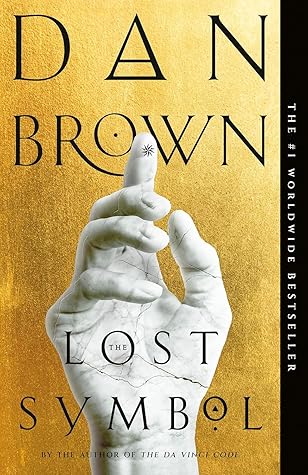More on this book
Community
Kindle Notes & Highlights
In fact, man’s oldest spiritual quest was to perceive his own entanglement, to sense his own interconnection with all things. He has always wanted to become ‘one’ with the universe . . . to achieve the state of ‘at-one-ment.’ ” Her brother raised his eyebrows. “To this day, Jews and Christians still strive for ‘atonement’ . . . although most of us have forgotten it is actually ‘at-one-ment’ we’re seeking.”
Melencolia I consisted of a brooding figure with giant wings, seated in front of a stone building, surrounded by the most disparate and bizarre collection of objects imaginable—measuring scales, an emaciated dog, carpenter’s tools, an hourglass, various geometric solids, a hanging bell, a putto, a blade, a ladder.
Katherine vaguely recalled her brother telling her that the winged figure was a representation of “human genius”—a great thinker with chin in hand, looking depressed, still unable to achieve enlightenment. The genius is surrounded with all of the symbols of his human intellect—objects of science, math, philosophy, nature, geometry, even carpentry—and yet is still unable to climb the ladder to true enlightenment. Even the human genius has difficulty comprehending the Ancient Mysteries.
“Symbolically,” Langdon said, “this represents mankind’s failed attempt to transform human intellect into godlike power. In alchemical terms, it represe...
This highlight has been truncated due to consecutive passage length restrictions.
Jeova Sanctus Unus. She knew its meaning at once. This phrase was ubiquitous in modern translations of Hebrew scripture. In the Torah, the God of the Hebrews was known by many names—Jeova, Jehovah, Jeshua, Yahweh, the Source, the Elohim—but many Roman translations had consolidated the confusing nomenclature into a single Latin phrase: Jeova Sanctus Unus. “One true God?” she whispered to herself.
Every spiritual metamorphosis is preceded by a physical one. Such was the lesson of all the great gods . . . from Osiris, to Tammuz, to Jesus, to Shiva, to the Buddha himself.
Sacrifice was the original ritual by which humans drew favor from the gods and made themselves holy. Sacra—sacred. Face— make.
Even Jesus himself said, ‘Nothing is hidden that will not be made known, nor secret that will not come to light.’”
“The cross,” Langdon said, “was not a Christian symbol until the fourth century. Long before that, it was used by the Egyptians to represent the intersection of two dimensions—the human and the celestial. As above, so below. It was a visual representation of the juncture where man and God become one.”
Since the days of Michelangelo, sculptors had been hiding the flaws in their work by smearing hot wax into the cracks and then dabbing the wax with stone dust. The method was considered cheating, and therefore, any sculpture “without wax”—literally sine cera—was considered a “sincere” piece of art. The phrase stuck. To this day we still sign our letters “sincerely” as a promise that we have written “without wax” and that our words are true.
“As I said when I began,” Solomon stated in conclusion, “James Smithson and our forefathers envisioned our great country to be a land of enlightenment. I believe today they would be proud. Their great Smithsonian Institution stands as a symbol of science and knowledge at the very core of America. It is a living, breathing, working tribute to our forefathers’ dream for America—a country founded on the principles of knowledge, wisdom, and science.”
To this day, children still shout ‘abracadabra’ in hopes of creating something out of nothing. Of course, we’ve all forgotten that this word is not a toy; it has roots in ancient Aramaic mysticism—Avrah KaDabra—meaning ‘I create as I speak.’ ”
“What does the word apocalypse literally mean?” “It means,” one student began, and then paused as if surprised. “Apocalypse means ‘to unveil’ . . . or ‘to reveal.’ ”
Solomon gave the boy a nod of approval. “Exactly. The Apocalypse is literally a reveal-ation. The Book of Reveal-ation in the Bible predicts an unveiling of great truth and unimaginable wisdom. The Apocalypse is not the end of the world, but rather it is the end of the world as we know it. The prophecy of the Apocalypse is just one of the Bible’s beautiful messages that has been distorted.”
Although many people erroneously interpreted apocalypse as a cataclysmic end of the world, the word literally signified an “unveiling,” predicted by the ancients to be that of great wisdom. The coming age of enlightenment.
“Laus Deo,” Langdon whispered. The well-known Latin phrase—meaning “praise God”—was inscribed on the tip of the Washington Monument in script letters only one inch tall. On full display . . . and yet invisible to all.
“A wise man once told me,” Peter said, his voice faint now, “the only difference between you and God is that you have forgotten you are divine.”
“Elohim,” he repeated. “The Hebrew word for God in the Old Testament! I’ve always wondered about it.” Katherine gave a knowing smile. “Yes. The word is plural.” Exactly! Langdon had never understood why the very first passages of the Bible referred to God as a plural being. Elohim. The Almighty God in Genesis was described not as One . . . but as Many. “God is plural,” Katherine whispered, “because the minds of man are plural.”
He pictured the tiny engraving on the east-facing side of the aluminum tip and realized to his amazement that the first ray of sunlight to hit the nation’s capital, every single day, did so by illuminating two words: Laus Deo.


